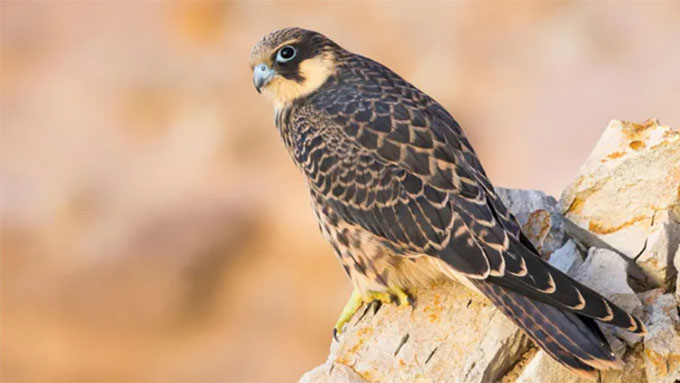Birds pluck their prey's feathers and put them in stone 'prisons'
The Eleonora falcon on Mogador island captures other small birds alive, plucks their flight feathers and stuffs them into rock crevices as a reserve food source.
The Eleonora falcon ( Falco eleonorae ) is a bird of prey that breeds in the Mediterranean and off the northwestern coast of Africa, wintering in Madagascar. They are not large in size, usually 36 - 42cm long with a wingspan of 87 - 104 cm. They often eat insects, bats and small birds.

The Eleonora falcon has a unique hunting strategy. (Photo: Saviero Gatto/Biosphoto/Alamy).
The special feature of the Eleonora falcon lies in its hunting strategy. Hunters capture small birds alive, pluck flight feathers (long, stiff feathers on the wings and tail that help birds fly) so they cannot fly, then stuff them into rock crevices or deep holes so they cannot escape. .
Curiously, only the Eleonora falcon population on the island of Mogador , off the west coast of Morocco, practices such captivity. This behavior was known to local fishermen, but ornithologists first described it in 2015, after conducting a kestrel population survey. Specifically, expert Abdeljebbar Qninba at Mohammed V University in Rabat, Morocco, and his colleagues encountered small birds stuck in deep cavities, losing their flight feathers and tail feathers. They cannot flap their wings or use their injured legs.

A small bird believed to have been held captive by the Eleonora falcon on the island of Mogador. (Photo: Abdeljebbar Qninba).
The research team believes that confining prey helps Eleonora kestrels keep their food source fresh until needed . Most prey species are songbirds, but there are also swallows, hatchlings and some wading birds. The team also believes that prey capture behavior is unique to the Mogador population as there have been no reports of this behavior in other Eleonora falcon populations or in other birds of prey.
However, some experts are still skeptical about the study results. According to Rob Simmons, a behavioral ecologist at the University of Cape Town in South Africa, the birds in the rock holes may just be fugitives hiding to avoid being killed.
All Eleonora kestrels eat birds during the nesting period , around July - October. They hunt migratory birds that are tired from flying long distances. They catch their prey in mid-flight. This hearty food source helps the Eleonora kestrel and its young prepare for their own migration to Madagascar. The rest of the year, they mainly eat insects such as dragonflies and butterflies.
- Why are birds not hairy when they are old?
- The origin of feathers in birds?
- 10 species of birds have beautiful long tail feathers
- 10 most beautiful birds on the planet
- Why is precious bird feather green?
- There are many strange birds near the Lai Chau Hydropower Project
- Prehistoric tail feathers stuck 100 million years in amber
- Fossil data reveal the origin of feathers
- There will be no more shiny shiny feathers, birds are gradually becoming 'fade' literally
- Why do many American prisons have to ban fruit circulation?
- Dinosaurs happened to fly when 'posing'
- Naming the birds 'successful puberty' makes everyone surprised
 Animal 'suffering' after hibernation
Animal 'suffering' after hibernation Why do goats climb well?
Why do goats climb well? Scientists were surprised to see chimpanzees eating turtles
Scientists were surprised to see chimpanzees eating turtles Giant catfish died deadly due to drought in Thailand
Giant catfish died deadly due to drought in Thailand